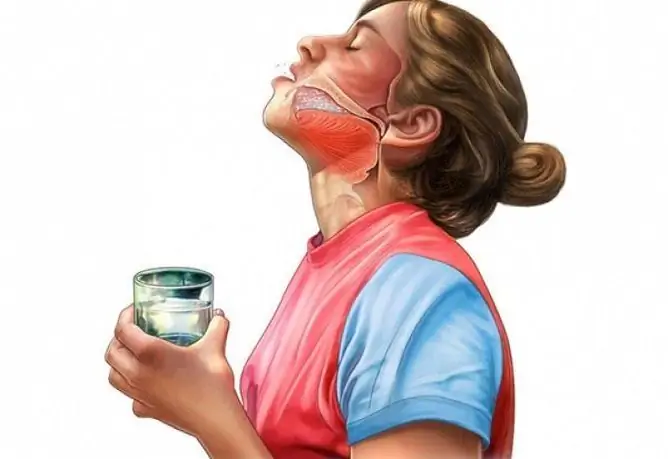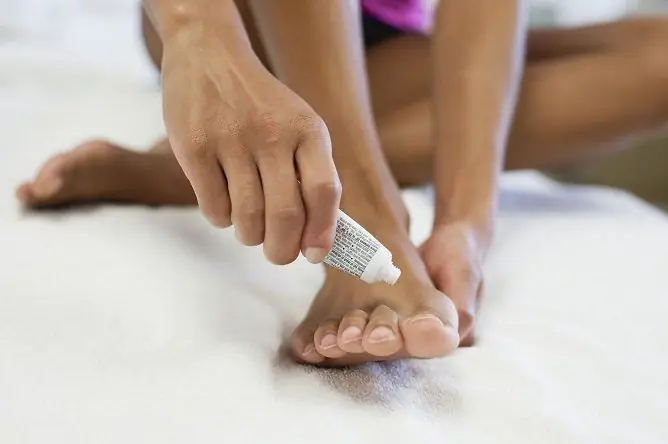- Author Rachel Wainwright [email protected].
- Public 2024-01-15 19:51.
- Last modified 2025-11-02 20:14.
What to do if your knees are swollen and sore
The content of the article:
- Swollen knee: causes and risk factors
- How edema manifests itself in different pathologies
- Diagnostics
-
What to do if your knee is swollen
- General measures
- Therapy
- Folk remedies
- Video
If a person's knees are swollen, this may indicate the development of serious diseases of the musculoskeletal system. This symptom accompanies diseases such as bursitis, synovitis, tendonitis, arthritis, arthrosis and some others.

In most cases, knee swelling is associated with injury to the soft or articular tissue
In the absence of timely treatment, the progression of joint damage can lead to difficulty in independent movement, up to disability. Therefore, when this symptom appears, it is recommended to immediately seek medical help and, if the disease is confirmed, to begin treatment in a timely manner.
Swollen knee: causes and risk factors
The main causes of a tumor in the knee joint include:
- inflammatory processes in the joints;
- pathology of the blood vessels;
- trauma;
- deformation of the joint.
The inflammatory process can lead to the development of knee swelling in patients of different age groups. The most common cause of pathology is arthritis, which can have an infectious or autoimmune etiology. Swelling is often caused by other inflammatory diseases of the joint tissues - bursitis, tendonitis, tendovaginitis.
Blood vessel abnormalities are another cause of knee swelling in patients of all ages. Most often, the occurrence of a pathological process occurs against the background of the following diseases:
- atherosclerotic vascular lesions of the lower extremities (usually in people over 40);
- varicose veins in the legs (often in women after childbirth);
- diabetic angiopathy in uncompensated diabetes mellitus;
- endarteritis (more often in young men).
Injuries are the cause of leg swelling in the knee area in young patients. Among the main traumatic reasons why the knee swells and hurts, there are:
- soft tissue contusion with large bruises is one of the most common causes of knee edema. In this case, swelling can appear directly when a person bruises his leg, or some time after being injured;
- sprain and / or rupture of tendon fibers, against the background of which blood accumulates in the formed cavities;
- dislocation of the knee joint, in which there is a stretching of the joint capsule, its deformation and inflammation;
- cracks and fractures of bones with damage to the periosteum and the occurrence of internal bleeding.
Deformation of the tissues of the knee joint, which can provoke the development of puffiness, can occur with the following pathologies:
- stretching and deformation of the joint capsules with calcification of their internal contents;
- cicatricial changes in ligaments and tendons;
- cysts in the synovial, tendon, cartilage and / or bone of the second fabric;
- thickening of the synovial membrane against the background of the inflammatory process;
- deformation of bone tissue and its destruction.
How edema manifests itself in different pathologies
The development of puffiness in the knee area is accompanied by impaired mobility (inability to fully bend and extend the leg at the knee). With different pathologies, this symptom may be accompanied by other manifestations:
| Pathology | Associated symptoms |
| Deformations and destruction of bone tissue | Severe swelling of soft tissues in the knee area, pain, severe limitation of mobility. |
| Vascular disorders | Knees are swollen and hurt, bruises, changes in pulsation, ulceration on the skin can be observed. In some pathologies of blood vessels, swelling is localized below the knee. |
| Thickening of the synovial membrane of the joint | Pain, hyperemia of the skin, limitation of mobility in the knee joint. |
| Knee cup offset | Discomfort when walking, pain increases sharply when trying to straighten the leg. |
| Sprained or torn knee ligaments | Pain and feeling unsteady. As a rule, a person cannot step on an injured limb. |
| Bursitis | Hyperemia of the skin at the site of edema, the pain increases sharply when trying to bend the leg at the knee. |
| Arthritis | Massive swelling, heaviness in the leg, fever, chills, joint pain even in the absence of stress. |
|
Osteoporosis |
Symptoms may worsen with changes in weather. |
Diagnostics
Diagnosis of diseases accompanied by swelling of the knee joints includes:
- collection of complaints and anamnesis;
- objective examination;
- laboratory tests (rheumatic tests, etc.);
- X-ray examination (allows to exclude narrowing of the joint space, the presence of calcium salt deposits, osteoarthritis);
- angiography (allows you to determine the pathology of the blood vessels);
- ultrasound (makes it possible to identify pathologies of muscles, tendons, ligaments, synovial bags);
- arthroscopy (allows you to examine the articular surfaces from the inside);
- magnetic resonance imaging (may be needed to clarify the diagnosis).
Not all of the listed methods are mandatory, often just an objective examination and radiography and / or laboratory diagnostics are sufficient.
What to do if your knee is swollen
In the early stages, many diseases in which the knees swell can be successfully treated with conservative therapy. As the disease progresses, more complex and prolonged treatment is required, and surgery may be necessary.
General measures
First of all, it is necessary to take a number of measures:
- Reduce the load on the affected leg (repetitive movements of the same type have an especially adverse effect).
- For a short time, you can apply a cold compress to the affected area (up to 4 times a day and no more than 15 minutes).
- For a while, take a position in which the affected knee is above the level of the heart (for example, using a pillow).
Therapy
The choice of a treatment regimen depends on the cause of the development of the pathological process. So, for bursitis and other inflammatory diseases, non-steroidal (and in some cases steroidal) anti-inflammatory drugs, analgesic compresses are prescribed, limiting the load on the affected limb is shown.
At a certain stage, physiotherapy exercises can be prescribed to strengthen the muscles and improve the blood supply to the knee tissues, massage, physiotherapy.

Physiotherapy exercises are prescribed for certain diseases to improve the functionality of the knee joints.
Folk remedies
After consulting with your doctor for this pathology, you can use folk remedies:
- Tincture of horse chestnut flowers. To prepare the product, 50 g of dry raw materials are poured into 500 ml of vodka and insisted for 1 week. The finished tincture is used for rubbing the affected area.
- Ointment based on honey and aloe. In case of inflammation of the joint tissues, a remedy is used, for the preparation of which ethyl alcohol, liquid honey and aloe juice are mixed in a ratio of 3: 2: 1.
- Cabbage leaf with honey. For a number of diseases accompanied by swelling and pain, you can use a cabbage leaf compress, which is beaten off a little with a wooden hammer until the juice is released, smeared with honey, applied to the knee, covered with cellophane and fixed with a thick cloth.
- Ointment with honey, onions and laundry soap. To prepare the product, 500 ml of honey is mixed with 1 chopped onion and 1 piece of grated laundry soap. In the chronic form of bursitis, compresses with this ointment can be done before bedtime.
- Sage baths. Baths with sage infusion can relieve inflammation and reduce pain, for which 15-20 tablespoons of dry grass are poured in 5 liters of boiling water, insisted for 2 hours, filtered and poured into a bath with prepared warm water. It is recommended to take such baths for arthritis for 10-15 minutes 1 week, after which you need to take a break for 5 days, if necessary, the course can be repeated.
Video
We offer for viewing a video on the topic of the article.

Anna Aksenova Medical journalist About the author
Education: 2004-2007 "First Kiev Medical College" specialty "Laboratory Diagnostics".
Found a mistake in the text? Select it and press Ctrl + Enter.






